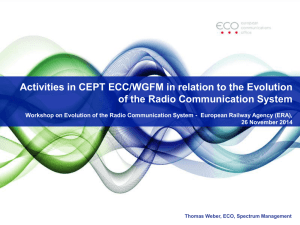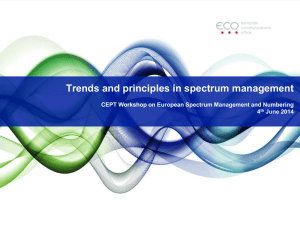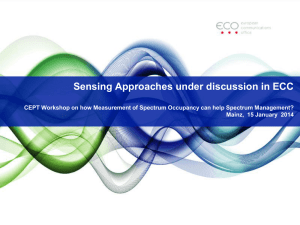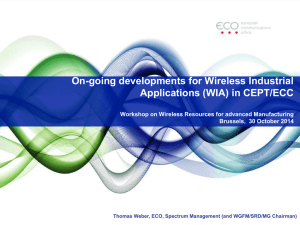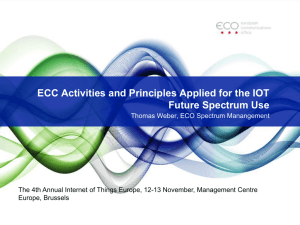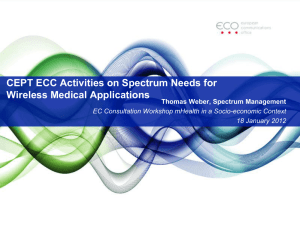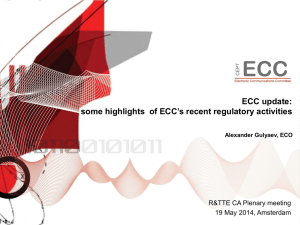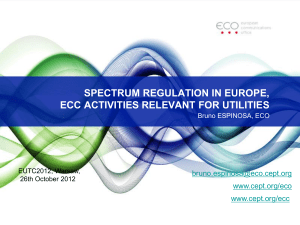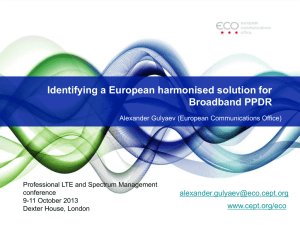TV WSD (White Space Devices) – Activities in the ECC
advertisement
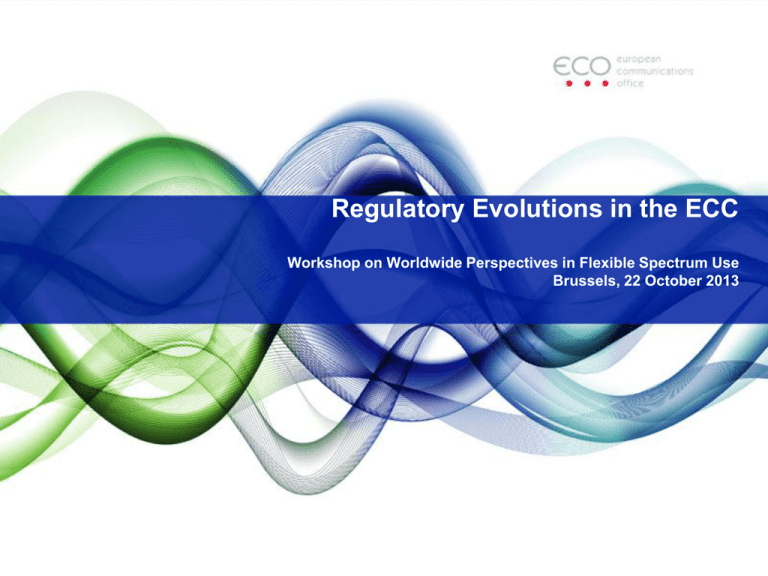
Regulatory Evolutions in the ECC Workshop on Worldwide Perspectives in Flexible Spectrum Use Brussels, 22 October 2013 Content • TV WSD (White Space Devices) – Activities in the ECC • Other ideas with regard to geo-location database usage • Cognitive PMSE • Tendencies for SRD applications’ use of mitigation techniques • 5 GHz considerations with regard to mitigation techniques • Licensed Shared Access (LSA) • Sharing principles for applications under general authorisations • Broadband Applications – Bundling of applications under the same technical framework • How research projects can feed the existing processes TV WSD (White Space Devices) – Activities in the ECC What we have in CEPT: • • • • ECC Report 159: Technical and operational requirements for the possible operation of cognitive radio systems in the ‘white spaces’ of the frequency band 470-790 MHz ECC Reports 185 “Further definition of technical and operational requirements for the operation of white space devices in the band 470-790 MHz” ECC Report 186 “Technical and operational requirements for the operation of white space devices under geo-location approach”. WGFM: A summary and analysis of the answers to the questionnaire on PMSE protection in case of introduction of WSD in the 470-790 MHz band. In progress: • • • WGFM PT FM53 work item for creation of a new ECC Report for TV-WSD (White Space Devices) using geo-location. The aim is to describe the overall regulatory framework for TV WSD using geo-location databases and guidance for national implementation. Delivery of this new ECC Report not before end of 2014. Lack of contributions so far. Only afterwards, possible creation of a harmonisation measure (e.g. ECC Recommendation). ECC never received a request from ETSI on TVWSD. Other ideas with regard to geo-location database usage • FM PT44 (satellite services) received a presentation on the CoRaSat project, which looks at different sharing scenarios between satellites and other terrestrial services (mostly Fixed Service) or other satellite applications, using cognitive and database methods. ETSI TC SES is creating an ETSI SRdoc (avail. Expected end of 2013). FM PT44 will deal with this. • Existing work items in WGFM/SRDMG and WGSE/SE24: Some fixed installed Applications such as Assistive Listening Devices in the VHF band (174-216 MHz) or in other spectrum (e.g. for telecoil replacement systems) are discussing geolocation approaches. • However: geolocation is only one of the options for sharing under discussion, other options such as LBT/frequency agility or bundling applications in spectrum which are unlikely to be operated at the same location may be more efficient (examples: ALDs and RFID reader channels in the 915-921 MHz, uncoordinated FSS in FS duplex gaps) and involve less burden in terms of technical complexity or for the administrations. Cognitive PMSE (C-PMSE) New draft ECC Report 204: Spectrum Use and Future Requirements for PMSE (in public consultation) • Initial research activities on cognitive PMSE systems have been initiated in ETSI STF 386 and in a German research project funded by BMWI (German Federal Ministry of Economics and Technology) called C-PMSE. • Great Potential: • Features several in-operation audio PMSE links can be transferred to less impaired spectrum when necessary – w/o noticeable interruptions • Can lead to more robust and more efficient use of spectrum, especially in UHF bands, including duplex band operations • It’s cognitive because the used frequencies are ”monitored” constantly / service quality checked all the time. Existing audio PMSE systems check only before tyhe event • A reaction to the changes in the UHF terrestrial broadcast spectrum • ETSI Technical Specifications as well as first demonstrator hardware available • It’s monitored in the ECO Research Activities w.r.t impact on work in the ECC Tendencies for SRD applications’ use of mitigation techniques Example: New band plan 870-876 MHz (from draft ECC Report 189; currently in public consultation – work triggered by 5 ETSI SRdocs) 500 mW (with APC), ≤200 kHz Up to 2.5% DC Metropolitan/Rural Area Networks. Up to 10% DC for Network Relay Points (Subject to notification, see Appendix 4)(ERC Rec 70-03 Annex 2) 500 mW (with APC), ≤500 kHz, 0.1 % DC TTT Vehicle to Vehicle only (ERC Rec 70-03 Annex 5) 100 mW (with APC) 0.1% DC TTT in vehicle only (ERC Rec 70-03 Annex 5) 25mW 1% DC ≤600 kHz (ERC Rec 70-03 Annex 1) 25mW 0.1% DC ≤200 kHz (ERC Rec 70-03 Annex 1) ER- RD 870 MHz 7 - 76 875.6 MHz Hz 875.8 MHz R- 876 MHZ Also: ECC Report 182 (Survey about the use of the frequency band 863-870 MHz) Duty Cycle Mitigation is very dominant ! 5 GHz considerations with regard to mitigation techniques • • • The draft ECC Report 192 on the current status of DFS (Dynamic Frequency Selection) in the 5 GHz frequency range was adopted to proceed to the public consultation. Severe interference into weather radars (> 200 reported cases in 2012) in a considerable number of European countries caused by outdoor LS-links links using WAS/RLAN equipment. Reasons: mainly intentional illegal use or non-compliant equipment. There is some motivation to switch off the DFS! Mitigation must fit to the application/intention (Bad examples: UHF RFID with LBT, Direct-Air-to-Ground with DAA to protect BFWA) Recent studies on WIA in SRD/MG and PT SE24 (Wireless Industrial Applications with higher emission levels up to 400 mW in 5725-5875 MHz: 5725-5875 MHz ≤ 400 mW e.i.r.p. APC required Adequate spectrum sharing mechanisms (e.g. DFS and DAA) shall be implemented by the equipment . • Modulation bandwidth ≥ 1 MHz and ≤ 20 MHz Wireless Industrial Automation (WIA) Networks The Adaptive Power Control has a range of at least 12 dB (dynamic range between 400 mW and 25 mW) DFS (protection of radiolocation), DAA (protection of BFWA, ITS, road tolling), APC based on potential outdoor use (indoor use is not the problem). Licensed Shared Access (LSA) The draft ECC Report 205 on Licensed Shared Access has been approval for public consultation – it includes some refinements of the LSA concept as set out in the respective draft RSPG opinion. Scope: LSA is a complementary spectrum management tool that fits under an “individual licensing regime”. LSA aim to facilitate the introduction in a frequency band of new users, which require a certain level of guarantee in terms of spectrum access, while maintaining incumbent services in the band. LSA licensees and incumbents operate different applications and are subject to different regulatory constraints. They would each have exclusive individual access to a portion of spectrum at a given location and time. LSA (II) The first practical use case of LSA will be to provide access to additional spectrum for mobile broadband services (MFCN) in 2.3-2.4 GHz. • The implementation of LSA relies on the concept of a “sharing framework” that is under the responsibility of Administration/NRA. Its development requires the involvement of all relevant stakeholders. • The “sharing framework” can be understood as a set of sharing rules or sharing conditions that will materialise the change in the spectrum rights of the incumbent(s) and define the spectrum, with corresponding technical and operational conditions, that can be made available for alternative usage under LSA. • The practical implementation of LSA as a complementary solution for mobile network operators for accessing spectrum for MFCN in specific bands, within specified geographical or technical limits and on the requirements to be included in CEPT “harmonisation measure”. The first harmonisation measure developed by CEPT that includes the possibility for implementation of LSA is for the introduction of MFCN in 2.3-2.4 GHz band. It can include geolocation ! Sharing principles for applications under general authorisations The SRD strategy and sharing principles are set out in CEPT Reports 14 and 44. Equal access to spectrum (and incumbents should not enjoy “seniority”) Technology- neutrality Application- neutrality (as much as possible) Investigate existing SRD spectrum and existing SRD categories first before considering new spectrum 5. Avoid fragmentation of the spectrum, search for more efficient sharing solutions 6. Foster innovation (broad SRD regulation is more open to new ideas than specific regulations) 1. 2. 3. 4. Examples: 1. New band plans 870-876, 915-921 MHz are more horizontal than vertical (e.g. 863-870 MHz) 2. Medical Applications: LP-AMI, MBANS, Cochlear in 2483.5-2500 MHz are foreseen to share on equal basis and using spectrum access mechanism such as LBT with frequency agility) Band Plan 915-921 MHz Note: RFID/ALD sharing Safe harbours Flat SRD regulation RFID DAA for EGSM-R 200 kHz of low DC RFID tag return RF ID @ 4 W SR D 10 0 m W 1 % RFID tag return RF ID @ 4 W SR D 10 0 m W 1 % RFID tag return RF ID @ 4 W SR D 10 0 m W 1 % RF ID @ 4 W SR D 10 0 m W 1 % RFID tag return RFID tag return 200 kHz Low DC 25 mW 1% DC Per 600 kHz channel. Channel bandwidth ≤ 600 kHz 25 mW 0.1% DC Per 200 kHz channel. Channel bandwidth ≤ 200 kHz ER- (ba e tation 1 - 21 Hz 918.5 918.9 MHz MHz 919.7 MHz mobile 915 915.3 MHz MHz 916.1 916.5 MHz MHz 917.3 917.7 MHz MHz 920.1 MHz R- 920.9 MHz 921 MHZ Broadband Applications – Bundling of applications under the same technical framework Example: 2 GHz Unpaired Bands: as a result of the synergies between PMSE and PPDR, as well as between DECT and SRD, the shortlist indicated in the EC Mandate, composed of five potential harmonised uses of the 1900-1920 MHz and 2010-2025 MHz frequency bands (DA2GC, PMSE, PPDR, DECT and SRD), is considered to be adequately studied by using 3 usage blocks. BB-Direct air to ground communications Video links and cordless cameras Applications under general authorisation PMSE DECT PPDR SRD DA2GC Video PMSE / ad-hoc PPDR: may also apply to studies in many other bands between 2.7-8.5 GHz (both should use the same technical framework) BB-Applications in general: we need to bundle, otherwise we run out of frequencies ! DECT/SRD: DECT proponents already recognised need for technology-neutral regulation. SRD again may use duty cycle mitigation. DECT uses DCS. No motivation for further mitigation mechanism developments. How research projects can feed the existing processes Almost all examples in this presentation used the ETSI- ECC coordination mechanisms (many SRD ETSI system reference documents, also LSA, TC SES, DECT aso.) Relevant principles are already in place in ETSI when preparing a new ETSI System Reference Document for the designation of spectrum for new demand. The SRdoc has to include the necessary justifications (e.g. information, why the application cannot fit into existing regulation or needs dedicated spectrum,, sharing possibilities) and undergoes a consultation process throughout the complete ETSI membership that gives often also existing spectrum users the possibility to include their view in the document. CEPT is subsequently provided with a consolidated ETSI view and not single interests. See: http://www.cept.org/ecc/who-we-are/ecc-and-etsi Another possibility is to approach ECC Project Teams and Working Groups and provide a presentation about your project. It can also be linked to the ECO Research activity (so we monitor w.r.t. impact/link on work in the ECC!) In case of doubt, contact your national administration or ECO for advice. Participating in ECC work: where to start Participating in ECrk: where to start www.cept.org/ecc Thank you for your attention Questions?? Thomas.Weber@eco.cept.org www.cept.org/eco www.cept.org/ecc
